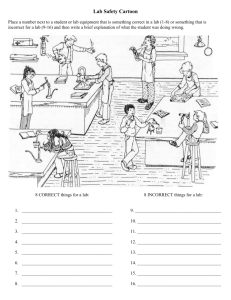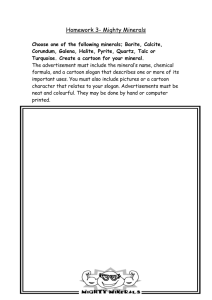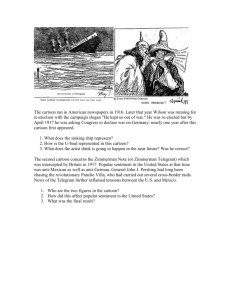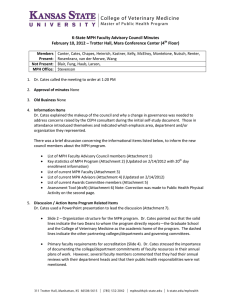Grade 12 Economics Exam September 2014 Paper 1
advertisement
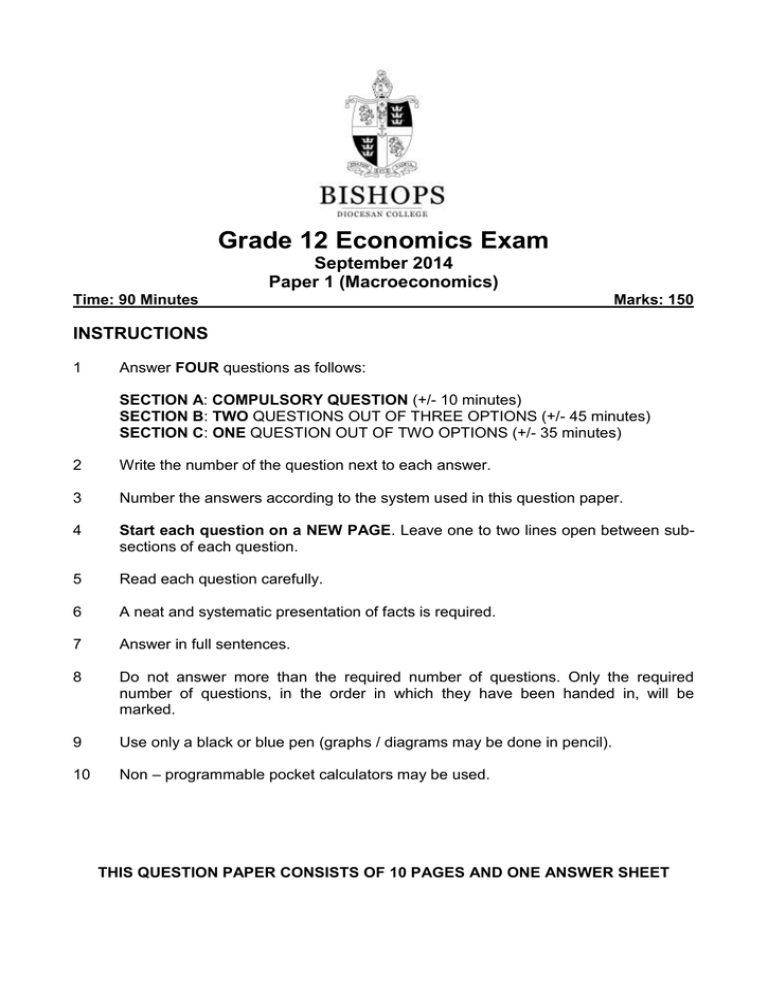
Grade 12 Economics Exam September 2014 Paper 1 (Macroeconomics) Time: 90 Minutes Marks: 150 INSTRUCTIONS 1 Answer FOUR questions as follows: SECTION A: COMPULSORY QUESTION (+/- 10 minutes) SECTION B: TWO QUESTIONS OUT OF THREE OPTIONS (+/- 45 minutes) SECTION C: ONE QUESTION OUT OF TWO OPTIONS (+/- 35 minutes) 2 Write the number of the question next to each answer. 3 Number the answers according to the system used in this question paper. 4 Start each question on a NEW PAGE. Leave one to two lines open between subsections of each question. 5 Read each question carefully. 6 A neat and systematic presentation of facts is required. 7 Answer in full sentences. 8 Do not answer more than the required number of questions. Only the required number of questions, in the order in which they have been handed in, will be marked. 9 Use only a black or blue pen (graphs / diagrams may be done in pencil). 10 Non – programmable pocket calculators may be used. THIS QUESTION PAPER CONSISTS OF 10 PAGES AND ONE ANSWER SHEET SECTION A (COMPULSORY) QUESTION 1 1.1 For each question there are three possible answers, A, B and C. Choose the one you consider correct and record your choice in the appropriate space on the ANSWER SHEET attached to the question paper. 1.1.1 If national income increases by R500 million as a result of an investment of R200 million, what is the value of the multiplier? A B C 2,5 0,4 5 1.1.2 Consumption of fixed capital is used to calculate GDP at … A B C basic prices market prices factor cost 1.1.3 A focus on the improvement of input efficiency is a characteristic of the … -side policy. A B C demand supply demand and supply 1.1.4 If the South African Reserve Bank sells foreign exchange to pay for deficits in the current account, this affects: A B C the financial account the capital transfer account the official reserve account 1.1.5 The process whereby previously disadvantaged groups of people are empowered in development is called … A B C Skills support programme (SSP) Black Economic Empowerment (BEE) National Development Plan (NDP) 1.1.6 The scorecard used to measure progress with Black Economic Empowerment (BEE) is published by the … A B C Amalgamated Banks of South Africa Development Bank of South Africa Department of Trade and Industry 2 1.1.7 Spatial areas that offer a passageway to mining, manufacturing and other businesses are referred to as … A B C gateways. corridors. export processing zones. 1.1.8 A corridor that links an area with growth potential to an area of higher economic activity in order to promote job creation and economic development is called: A B C an SDI an IDZ a DTI (8 x 2 = 16) 1.2 Choose a description from COLUMN B that matches an item in COLUMN A. Write only the letter (A – J) next to the question number (1.2.1 – 1.2.8) on your ANSWER SHEET. COLUMN A 1.2.1 Comparative advantage 1.2.2 Marginal propensity to save COLUMN B A B The portion of an increase in income that is not consumed. Ratio between the eventual change in income and the initial investment. 1.2.3 Public goods C A limit on the quantity that can be imported 1.2.4 The BoP current account D Produces goods at a lower input cost than other countries. 1.2.5 Dualistic E Believes that markets are inherently stable 1.2.6 Import quota F Non-rival and non-excludable 1.2.7 Exogenous approach G Provides loans to developing countries 1.2.8 World Bank H A country where a developed component co-exists with a developing component I Reflects a country’s net income J The two sector circular flow model can also be referred to as being … (8 x 1 = 8) 3 1.3 Complete the following statements by using the words provided in the list below. Write only the word next to the question number (1.3.1 – 1.3.6) on your ANSWER SHEET. The new economic paradigm; Lorenz curve; NEPAD; Laffer curve; current transfer; capital transfer; devaluation; revaluation; import substitution; export promotion; SACU; SADC 1.3.1 Some of the income tax collected by the government is used to finance the payment of pensions. 1.3.2 Some countries fix the value of their currency in terms of other currencies. When the value of the currency is adjusted and fixed at a lower rate it is called … 1.3.3 SASOL and Mossgas (now PetroSA) are examples of … 1.3.4 An approach that comprises of both demand and supply side policies. 1.3.5 This models the idea that there is an optimal level of tax for the government to charge. 1.3.6 This free trade area would encourage economies of scale with competitive industries that would increase intra-regional trade and boost foreign investment to the region. (6 x 1 = 6) [30] 4 SECTION B (ANSWER TWO QUESTIONS FROM THREE) QUESTION 2 (Macroeconomics) 2.1 Name TWO of South Africa’s macro-economic objectives. 2.2 Study the information below and answer the question that follows. 2.2.1 2.2.2 2.2.3 2.2.4 2.2.5 Differentiate between GDP and GNP. Which alternative term is used for GDP in the national accounts? Provide labels for A and C. Calculate B. Which component contributed most to the GDP? 2.3 Study the following cartoon and answer the questions that follow. (2 x 2 = 4) (2) (2) (2) (2) (2) 5 2.3.1 Define economic growth. (2) 2.3.2 Identify two organizations represented in the cartoon. (2) 2.3.3 Which person (not organization) in the cartoon is responsible for monetary policy in South Africa? (2) 2.3.4 Briefly explain one possible policy instrument that the person identified in 2.3.3 could use to stimulate economic growth. (2) 2.3.5 In your opinion, what is the core message of the cartoon? (2) 2.4 Discuss the exogenous approach as a cause of business cycles. (4 x 2 = 8) 2.5 Discuss the workings of the Keynesian multiplier in a four sector model. Focus in particular on the economic effect of Foreign Direct Investment on the South African economy. (4 x 2 = 8) [40] QUESTION 3 (Economic Pursuits) 3.1 Name any TWO indicators that show important information about education in a country. (2 x 2 = 4) 3.2 Use the data in the table to answer the questions that follow. 3.2.1 Identify the person depicted in the cartoon. (2) 3.2.2 Apart from poverty eradication and job creation, name two other aims of the NDP. (2) 3.2.3 Briefly comment on government’s plans to address poverty eradication as part of the NDP. (2) 3.2.4 Why is the main character in the cartoon peeking to his left? (2) 3.2.5 Explain / comment on the title “Uncle Trevor wants you”. (2) 6 3.3 Study the following extract and answer the questions that follow: 3.3.1 3.3.2 3.3.3 3.3.4 3.3.5 What does the abbreviation IDZ mean? (2) State the aim of the IDZ’s within the South African economy. (2) What is the purpose of EIDD? (2) In 2012 the IDZ’s were converted into SEZ’s. Explain. (2) Does the DTI contribute to the supply or demand side approach to economic growth? (2) 3.4 Supply side policies focus on the ability of markets to supply enough goods and services to meet aggregate demand. Briefly discuss this statement by focusing on the effectiveness and efficiency of markets in the South African context. (2 x 4 = 8) 3.5 Explain any two differences between the developed countries in the North and developing countries in the South. Make use of examples where appropriate. (2 x 4 = 8) [40] 7 QUESTION 4 (Macro & Economic Pursuits) 4.1 Name TWO examples of an indirect tax. 4.2 Study the following extract and answer the questions that follow: (2 x 2 = 4) 4.2.1 4.2.2 4.2.3 4.2.4 The World Bank uses 2000 as the base year? What does that mean? (2) Why do we use constant prices when comparing GDP per capita? (2) Identify the trend visible from the data provided. (2) Name the single biggest shortcoming when using GDP per capita for comparison purposes. (2) 4.2.5 Which other indicator could be used to measure the problem identified in 4.2.4? (2) 4.3 Study the cartoon below and answer the questions that follow: 4.3.1 How did the first democratically elected South African government address the problems illustrated by the cartoon after the 1994 elections? (2) 4.3.2 Which social indicator can be used to measure a country’s performance when addressing these issues? Explain. (4) 4.3.3 Which type of government policy can be used to address the issues depicted in the cartoon? (2) 4.3.4 Why can national debt be regarded as a burden on future generations? (2) 8 4.4 Explain the working of the Current account in the Balance of Payments. Make use of appropriate examples. (2 x 4 = 8) 4.5 Briefly explain two of the regional development policies as implemented by the South African government. (2 x 4 = 8) [40] SECTION C (ANSWER ONE ESSAY QUESTION FROM TWO) Your answer will be assessed as follows: STRUCTURE OF THE ESSAY: Introduction Body: Main part: Discuss in detail/In-depth discussion/Examine/ Critically discuss/Analyse/Compare/Evaluate/Distinguish/ Explain/Assess/Debate Additional part: Give own opinion/Critically discuss/Evaluate/ Critically evaluate/Draw a graph and explain/Use the graph given and explain/Complete the given graph/Calculate/Deduce/ Compare/Explain/Distinguish/Interpret/Briefly debate Conclusion TOTAL MARK ALLOCATION: Max. 2 Max. 26 Max. 10 Max. 2 40 QUESTION 5 (Macroeconomics) “It is the work of economists to analyse events as they happen, to explain them and to predict or forecast their future behaviour.” – Mike Levin Discuss how business cycle indicators are used in forecasting. Make use of a diagram to explain a typical business cycle. (26) Conclude your discussion with a note to the local business chamber indicating why you think we are at a certain point in the cycle. (10) [40] PTO 9 QUESTION 6 (Economic Pursuits) Source: World Bank Data 2014 Explain and discuss each of the economic and social indicators depicted above for the South African economy. (26) Using the information contained in them, analyse the state of economic development in South Africa (10) [40] 10 Grade 12 Economics Exam September 2014 Paper 1 (Macroeconomics and Economic Pursuits) ANSWER SHEET NAME: _______________________________ A B C D TEACHER: SH / CCS / WHS 1.3.1 1.1.1 1.3.2 1.1.2 1.3.3 1.1.3 1.3.4 1.1.4 1.3.5 1.1.5 1.3.6 1.1.6 1.1.7 1.1.8 1.2.1 1.2.2 1.2.3 1.2.4 1.2.5 1.2.6 1.2.7 1.2.8 11


